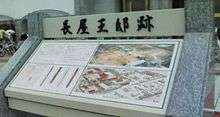Prince Nagaya
Nagaya (長屋王 Nagaya-no-ōkimi) (684 – 20 March 729) was a politician of the Nara period and an imperial prince of Japan, a son of Prince Takechi (grandson of Emperor Tenmu).
| Prince Nagaya | |
|---|---|
| Born | 684 |
| Died | 20 March 729 (aged 44–45) Nara, Japan |
| Spouse |
|
| Issue |
|
| Father | Prince Takechi |
| Mother | Princess Minabe |


His father was Prince Takechi and his mother Princess Minabe (a daughter of Emperor Tenji and Empress Genmei's sister). He married Princess Kibi (his cousin, a daughter of Empress Genmei and Empress Genshō's sister).
He was substantially influential in politics owing to his membership of the Imperial family of the most noble birth, and there were no other competitive Imperial members at that time. A large residence was allocated to him in a prestigious part of Heijō-kyō.
The Fujiwara clan were the most powerful competitors of Nagaya. Fujiwara no Fuhito, the leader of the house, had been the most powerful courtier in the court in the days when Japan was under the reign of Empress Genshō, a cousin of Nagaya's. After Fuhito's death in 720, Nagaya seized complete power within the court. This power shift was the source of later conflicts between him and Fuhito's four sons (Muchimaro, Fusasaki, Maro and Umakai) in the reign of Emperor Shōmu.
In 729, the four sons charged him with a false crime and Nagaya received the death penalty. He was forced to commit suicide. His wife, Princess Kibi, and his children were killed at the same time.
Wives and children
- Princess Kibi (?–729)
- Prince Kashiwade (?–729)
- Prince Katsuragi (?–729)
- Prince Kagitori (?–729)
- A lady of Ishikawa clan
- Prince Kuwata (?–729)
- Fujiwara no Nagako, daughter of Fujiwara no Fuhito
- Prince Asukabe (?–?)
- Prince Kibumi (?–757)
- Prince Yamashiro(Fujiwara no Otosada) (?–763)
- Princess Kyōshō, a nun
- Abe no Ōtoji
- Princess Kamo (?–?)
- Princess Chinu
- Princess Madokata (?–774)
Nagaya's Curse
It is said that, as Prince Nagaya was forced to die unreasonably, he bore a grudge against the living after his death. The following are believed to have been the victims of Nagaya's curse:
Muchimaro, Fusasaki, Maro and Umakai, responsible for the prince's death, caught smallpox one after another and eventually all of them died during a major Japanese smallpox epidemic in 737.
- In 1988, the former site of Nagaya's residence was discovered with many wooden tablets and historic relics on the construction site of a Sogo department store. Sogo did not care and continued construction. Twelve years after the store's completion, Sogo went bankrupt.